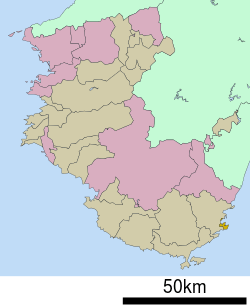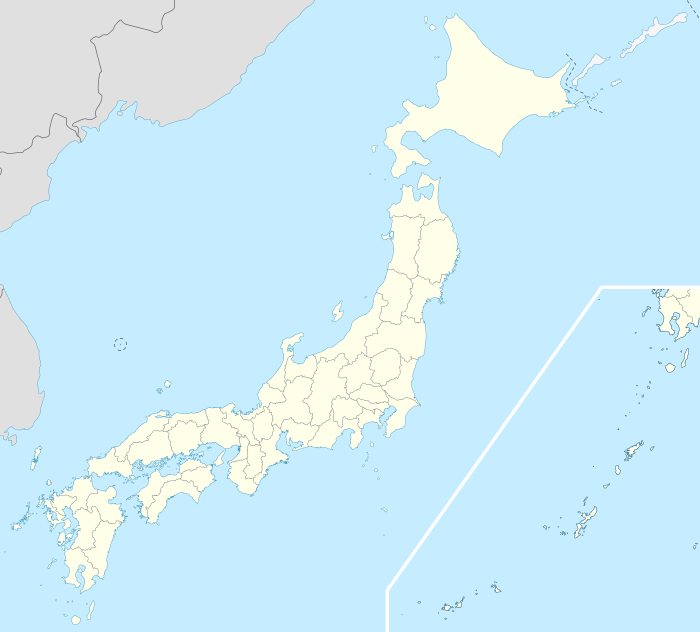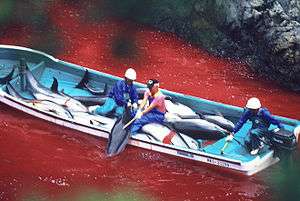Taiji, Wakayama
| Taiji 太地町 | |
|---|---|
| Town | |
|
Central Taiji, as viewed from the south, with the marina in the center and the Pacific is to the right | |
 Location of Taiji in Wakayama Prefecture | |
 Taiji Location in Japan | |
| Coordinates: 33°36′N 135°57′E / 33.600°N 135.950°ECoordinates: 33°36′N 135°57′E / 33.600°N 135.950°E | |
| Country | Japan |
| Region | Kansai |
| Prefecture | Wakayama Prefecture |
| District | Higashimuro |
| Government | |
| • Mayor | Kazutaka Sangen |
| Area | |
| • Total | 5.96 km2 (2.30 sq mi) |
| Population (31 March 2011) | |
| • Total | 3,428 |
| • Density | 541/km2 (1,400/sq mi) |
| Symbols | |
| • Tree | Evodia meliifolia |
| • Flower | Grand Crinum Lily |
| • Bird | Blue Rock-thrush |
| Time zone | Japan Standard Time (UTC+9) |
| City hall address | 649-5171 |
| Website |
www |
Taiji (太地町 Taiji-chō) is a town located in Higashimuro District, Wakayama Prefecture, Japan.
As of March 31, 2011, the town had an estimated population of 3,428[1] and a population density of 541 persons per km². The total area is 5.96 km². Taiji is the smallest local government by area in Wakayama Prefecture because, unlike others, it has not experienced a merger since 1889, when the village of Moriura was merged into Taiji. Taiji shares its entire overland border with the town of Nachikatsuura and faces the Pacific Ocean.
Taiji has long been well known as a whaling town and spearheaded the development of more sophisticated whaling techniques in the 17th century. In 1988, a ruling by the International Whaling Commission (IWC) caused Taiji to suspend commercial whaling. However, the town continues to hunt small whales and dolphins. Taiji's annual dolphin hunt is a subject of controversy and the town faces continued pressure from protest groups.[2]
History
Taiji has been primarily known as a whaling town.[3] Japanese traditional whaling techniques were developed here in the 17th century, and the commercial hunting and catching of dolphins remains a major source of income for its residents to this day.[4] Wada Chūbei organized the group hunting system (刺手組) and introduced a new handheld harpoon in 1606. Wada Kakuemon, later known as Taiji Kakuemon, invented the whaling net technique called Amitori hō (網取法) to increase the safety and efficiency of whaling. This method was applied for more than 200 years.
The people of Taiji experienced great loss and economic hardship after an incident in 1878, when a large group of whalers were lost at sea while while hunting a whale. The whale was harpooned, but was strong enough to pull the whaling boats out to sea. Refusing to cut the whale loose until it was too late, many whalers drowned or were otherwise adrift and lost at sea as a result. Around one hundred whalers died in the course of this event.[5] After the Russo-Japanese War, Taiji's whaling industry became buoyant again as it became a base for modern whaling. When the practice of Antarctic whaling started, Taiji provided crews for the whaling fleet.[6] In 1988, Taiji suspended commercial whaling as a result of a ruling by the International Whaling Commission (IWC).
Whalers from the town of Taiji continue to hunt small whales such as melon-headed and pilot whales as well as dolphins; commercial activities which are not regulated by the IWC. Whalers from Taiji also participate in the annual hunt for minke whales[7] which is sanctioned under IWC regulations for scientific purposes. According to the Fisheries Research Agency, 1,623 dolphins were caught in Wakayama Prefecture; this figure represents about 13% of the total national dolphin catch for that year.[8] In 2008, 1,484 dolphins and whales were caught. In 2009, 2,317 dolphins and whales were caught, just under the town's self-imposed quota of 2,400.[9]
Dolphin drive hunting
When a pod of dolphins has been spotted, whalers in small, coastal boats close in, lower metal pipes into the water, and begin striking the pipes. The sound repulses and confuses the dolphins, and the whalers can herd the pod toward the mouth of a bay. When the dolphins are in the bay, it is quickly closed off with nets so the dolphins cannot escape. The dolphins are left to calm down over night, and the following day, the dolphins are caught one by one and killed. In the past, whalers preferred to kill the dolphins by cutting their throats, but the Japanese government banned this method and now dolphins may only be killed by driving a metal pin into the neck area of the dolphin, which purportedly causes a very rapid death.[10][11] The speed of death is a topic of discussion, and in one case, a team reported that death took up to four minutes.[12]
A few dolphins from each hunt may be selected for captivity and sold to marine parks around the world. In May 2015, the World Association of Zoos an Aquariums (WAZA) banned the sale and transfer of captive dolphins from Taiji, Japan. Dolphins are sold to marine parks and swim-with-dolphin resorts that do not belong to WAZA.[13]
Results of 2015-2016 Drive Hunt*
| Species | Driven | Killed | Captured | Release | Quota |
|---|---|---|---|---|---|
| Bottlenose | 262 | 66 | 104 | 92 | 462 |
| False Killer Whale | 0 | 0 | 0 | 0 | 70 |
| Pantropical Spotted | 0 | 0 | 0 | 0 | 400 |
| Pacific White Sided | 4 | 0 | 4 | 0 | 134 |
| Short-finned pilot whale | 74 | 51 | 1 | 22 | 101 |
| Risso's dolphin | 272 | 245 | 8 | 19 | 256 |
| Striped Dolphin | 290 | 290 | 0 | 0 | 450 |
- Ceta-base, as of 29-Feb-2016[14]


Documentary
The town's annual dolphin drive hunt was featured in the 2009 documentary The Cove. Some people who appeared in the film, including Taiji assemblyman Hisato Ryono, have stated that the documentary's producers lied to them about the film's intended content.[15] Since the film's release, more activists than before, many from outside Japan, have gone to Taiji to observe or protest the annual dolphin slaughter which usually begins in September 1 and continues through the end of February. As a result, the town announced in July 2011 that it was reinforcing its police presence at the cove where the killings take place by operating a 24-hour, 10-man kōban in order to prevent confrontations between activists and locals.[16]
Sightseeing
Museums
- Taiji Whale Museum opened in 1969. It exhibits more than 1,000 items related to whales and whaling, including skeletal displays of several whale species. It keeps captive dolphins obtained by the Taiji dolphin drive hunt on display and uses the museum as a transfer station prior to distributing animals to dolphinariums worldwide.
- Hiromitsu Ochiai Baseball Museum commemorates Japanese baseball player Hiromitsu Ochiai who won the Nippon Professional Baseball triple crown three times.
- Ishigaki Museum commemorates painter Eitaro Ishigaki who hailed from Taiji. His wife Ayako founded the museum in 1991.
Onsens (hot springs)
There are two small-scale onsens (hot springs) in the town:
- Taiji Onsen
- Natsusa (or Nassa) Onsen
Festivals
Taiji's summer festival is called the Taiji Isana Festival that is held annually on 14 August.[17] Isana is an old Japanese word for whales. Its annual autumn festival is the Taiji Kujira Matsuri ("Taiji Whale Festival"), held on the first Sunday of November. Both festivals are heavily whale-themed and the attractions include the Kujira Odori ("whale dance") and the Kujira Daiko ("whale drumming"). The Kujira Odori is a traditional dance that whalers performed in the past to celebrate a good catch. This dance is unique, as the dancers only move their upper bodies as they dance sitting in whaling boats. It is identified as intangible cultural heritage by Wakayama Prefecture.[18] The Kujira Daiko is also traditional and its performance describes a battle between a large whale and small whaling boats.
Transportation
Railway
The Kisei Main Line of JR West runs through Taiji. Taiji Station is the only station in the town and is located just outside the Moriura area. A circular bus line connects the station with the tourist areas and the town hall. All Local trains and some Express trains stop at Taiji Station.
Roads
The main roads that run through Taiji are as follows:
- National highway route 42
- Wakayama prefectural road route 289
- Wakayama prefectural road route 240
Education
- Taiji Elementary School
- Taiji Junior High School
There are no high schools or universities.
Mercury concerns
In 2009, hair samples from 1,137 Taiji residents were tested for mercury by the National Institute for Minamata Disease (NIMD). The average amount of methylmercury found in the hair samples was 11.0 parts per million for men and 6.63 ppm for women, compared with an average of 2.47 ppm for men and 1.64 ppm for women in tests conducted in 14 other locations in Japan. From the total population, 182 Taiji residents who showed relatively high mercury levels over 7.2 ppm, including 18 men and 5 women over 50 ppm, underwent further medical testing to check for neurological symptoms of mercury poisoning.[19] None of the Taiji residents displayed any of the traditional symptoms of mercury poisoning, according to the Institute.[20][21] However, the Japan Times reported that the mortality rate for Taiji and nearby Kozagawa, where dolphin meat is also consumed, is over 50% higher in comparison to some other similarly sized villages in other regions of Japan.[22] However, the study makes no mention of specific causes of death nor does it mention relevant age demographics: as Taiji has 1,225 elderly residents (aged 65 years or older)[23] and Kozagawa has 1,531 elderly residents,[24] both towns have more elderly residents, up to twice as many, as towns mentioned in the study, such as Hiezuson, Tottori (699).[25]
The chief of the NIMD, Kōji Okamoto, said, "We presume that the high mercury concentrations are due to the intake of dolphin and whale meat. There were not any particular cases of damaged health, but seeing as how there were some especially high concentration levels found, we would like to continue conducting surveys here."[26]
NIMD ran further tests in 2010 and 2011. Hair from 700 Taiji residents were tested for mercury; 117 males and 77 females who showed over 10 ppm underwent further neurological tests. Again, no participant displayed any signs of mercury poisoning.[27] In August 2012, a research project to investigate the health effects of mercury on children was launched by NIMD.[28]
Sister cities
- Broome, Western Australia (Australia) since 1981; suspended by the Broome city council in August 2009 in protest against the annual dolphin slaughter.[29] The decision on suspension was reversed in October 2009.[30] Historic ties between the two towns date back to the early 1900s when Japan became instrumental in laying the groundwork of Broome's pearling industry.[30]
- Hakuba, Nagano (Japan) since 1984
Notable people
- Eitaro Ishigaki (1893–1958), an American artist
- Kiwako Taichi (1943–1992), an actress; originally her surname was pronounced Taiji, but she decided to pronounce it Taichi as a stage name.[31]
See also
- Dolphin drive hunting in Japan
- Dolphin meat in Japanese cuisine
- Juro Oka—"Father of Japanese Whaling"
- Pilot whale in Japanese cuisine
References
- ↑ Taiji Town Hall statistics.
- ↑ McCurry, Justin (2009-09-14). "Dolphin slaughter turns sea red as Japan hunting season returns". The Guardian. London. Retrieved 2010-05-24.
- ↑ Sowa, Frank: Seaside Communities in Crisis: On the Construction of Collective Identity in a Japanese Whaling Town after the Moratorium, in: Annuals of Marine Sociology/Roczniki Socjologii Morskiej, Jg. XXIII (2014), 21-35.
- ↑ Harnell, Boyd (August 1, 2007). "Taiji officials: Dolphin meat 'toxic waste'". The Japan Times Online. Retrieved 2014-04-26.
- ↑ C. W. Nicol (1979), Taiji - Winds of Change, article retrieved 6 February 2008.
- ↑ 懐かしの商業捕鯨フォトギャラリー [Commercial whaling photo gallery of nostalgia] (in Japanese). Simetani.com. Retrieved 2014-04-26.
- ↑ 太地便り [Taiji will share] (in Chinese). Simetani.com. Retrieved 2014-04-26.
- ↑ Matsutani, Minoru (25 August 2009). "Taiji told to stop dolphin carnage or sister ties end". The Japan Times. Retrieved 10 August 2011.
- ↑ "Taiji dolphin hunt begins: about 100 dolphins and 50 pilot whales driven into cove". Japan Probe. 9 September 2009. Retrieved 10 August 2011.
- ↑ Kjeld Duits (2005), Japan correspondent for Environmental News Service (ENS). Activists Worldwide Protest Japan's Dolphin Slaughter, ENS article retrieved on June 21, 2008.
- ↑ Butterworth, Andrew; Brakes, Philippa; Vail, Courtney S.; Reiss, Diana (2013-01-01). "A veterinary and behavioral analysis of dolphin killing methods currently used in the "drive hunt" in Taiji, Japan". Journal of applied animal welfare science: JAAWS. 16 (2): 184–204. doi:10.1080/10888705.2013.768925. ISSN 1532-7604. PMID 23544757.
- ↑ Butterworth, A.; Brakes, P.; Vail, C. S.; Reiss, D. (2013). "A Veterinary and Behavioral Analysis of Dolphin Killing Methods Currently Used in the "Drive Hunt" in Taiji, Japan". Journal of Applied Animal Welfare Science. 16 (2): 184. doi:10.1080/10888705.2013.768925.
- ↑ McCurry, Justin (2015-05-20). "Japanese aquariums vote to stop buying Taiji dolphins". The Guardian. ISSN 0261-3077. Retrieved 2016-02-02.
- ↑ "Drive Hunt Results". Ceta-Base. Retrieved 2016-02-02.
- ↑ Alabaster, Jay (20 March 2010). "Cove Oscar Won't End Taiji Dolphin Kill". Japan Times. Associated Press. p. 2.
- ↑ "Taiji to beef up police for hunt". The Japan Times. Kyodo News. 21 July 2011. p. 2. Retrieved 20 July 2011.
- ↑ 太地の出来事2008年 (in Chinese). Simetani.com. Retrieved 2014-04-26.
- ↑ 県指定文化財・民俗文化財 [Folk Cultural Property Prefecture designated cultural property] (in Chinese). Pref.wakayama.lg.jp. Retrieved 2014-04-26.
- ↑ "http://www.nimd.go.jp/kenkyu/report/20100427_taiji_report.pdf"
- ↑ Matsutani, Minoru, "Taiji locals test high for mercury: In surprise, experts fail to discover any signs of illness", The Japan Times, 10 May 2010, p. 1.
- ↑ Matsutani, Minoru, "Most Taiji residents rest easy, refuse to change diet", The Japan Times, 10 May 2010, p. 2.
- ↑ Harnell, Boyd, "Experts fear Taiji mercury tests are fatally flawed", Japan Times, 23 May 2010, p. 12.
- ↑ "Taiji, Wakayama". Jinko Watcher (in Japanese). 2010–2011. Retrieved 14 January 2012.
- ↑ "Kozagawa, Wakayama", Jinko Watcher, 2010–2011, retrieved 14 January 2012
- ↑ "Hiezuson, Tottori". Jinko Watcher (in Japanese). 2010–2011. Retrieved 14 January 2012.
- ↑ Yomiuri Shimbun 10 May 2010 Archived 27 July 2011 at the Wayback Machine.
- ↑ "Taiji residents relieved to hear 'it's safe' again", Asahi Shinbun, 31 May 2012.
- ↑ "Investigation of mercury health effect on elementary school children in Taiji", Yomiuri Shinbun, 7 Aug 2012.
- ↑ "Taiji told to stop dolphin carnage or sister ties end". The Japan Times. 25 August 2009. Retrieved 25 August 2009.
- 1 2 "Australian town embraces Taiji again". The Japan Times. 15 October 2009. Retrieved 21 October 2014.
- ↑ 吉行淳之介『新面白半分対談』p.146(講談社、1975年)
External links
| Wikimedia Commons has media related to Taiji, Wakayama. |
- Official town website (Japanese)